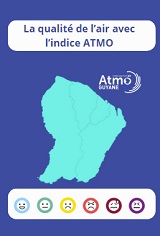Blada.com
jeudi 03 juillet
Boîtes aux lettres
Courrier des lecteurs
Petites annonces
Emploi / Formation
Covoiturage
Infos citoyennes
Infos citoyennes
15/02/23
Propos de l’Association Maiouri Nature : Réaction de la Collectivité Territoriale de Guyane
 La Collectivité Territoriale de Guyane (CTG) tient à apporter des éléments de réponse aux propos de l’Association Maiouri Nature Guyane vis-à-vis des dérogations aux critères de durabilité et de réduction des gaz à effets de serre à partir de biocarburants, bioliquides et biocombustibles issus de la biomasse, pour la production électrique et le transport.
La Collectivité Territoriale de Guyane (CTG) tient à apporter des éléments de réponse aux propos de l’Association Maiouri Nature Guyane vis-à-vis des dérogations aux critères de durabilité et de réduction des gaz à effets de serre à partir de biocarburants, bioliquides et biocombustibles issus de la biomasse, pour la production électrique et le transport.
Celle-ci défend non seulement le point de vue suivant : « La France veut raser la forêt amazonienne pour faire décoller des fusées " bio " ? », mais également évoque les points suivants :
• L’intensification des prélèvements de bois en forêt pour la production d’électricité ;
• Le remplacement de parcelles par des plantations monocultures pour la création d’agrocarburant ;
• Les dizaines de milliers d’hectares concernés par cette action ;
• L’industriel biomasse qui serait privilégié sur l’attribution des terres face à un agriculteur.
La Collectivité Territoriale de Guyane tient tout d’abord à rappeler que l’alimentation des 3 centrales de biomasse fonctionnant aujourd’hui sur le territoire guyanais se fait grâce aux dégâts d’exploitation forestière, aux connexes de scierie, aux déchets de la seconde transformation du bois et des résidus issus de l’aménagement du territoire (défriche urbaine et industrielle).
1. Concernant le premier point, il n’est pas question d’intensification au niveau des prélèvements de bois en forêt pour la production d’électricité.
La gestion durable de la forêt guyanaise est assurée par l’Office Nationale des Forêts (ONF) et différents outils sont développés afin d’assurer la traçabilité de cette ressource. Également, l’interaction avec les différents services de l’Etat au niveau régional permet de cadrer tout type de culture de bois énergie amené à se développer sur le territoire et aucun financement public ne sera attribué à la biomasse afin de solvabiliser une déforestation présentée de manière indirecte.
De plus, la CTG connait les contraintes de la filière biomasse en Guyane en termes d’approvisionnement. S’orienter vers une production plus importante de biomasse forestière conduirait à un risque de surexploitation des forêts et serait catastrophique :
• D’un point de vue économique, avec un coût lié à l’exploitation et au transport de plus en plus important ;
• D’un point de vue environnemental, étant donné que l’exploitation se fera de plus en plus loin dans les massifs ;
• D’un point de vue énergétique, par le manque de ressource dû à l’impraticabilité des pistes forestières en saison des pluies.
Pour l’objectif de 40 MW en 2023 de la PPE actuelle, ce sont 488 000 tonnes/an de biomasse à 45% d’humidité qui sont attendues et 732 000 tonnes/an de biomasse à 45% d’humidité pour 20 MW supplémentaires en 2030.
La nécessité de s’orienter vers un modèle non basé sur la surexploitation des massifs s’impose au vu des spécificités guyanaises, de la forte démographie, des besoins énergétiques et des orientations politiques.
2. Par la suite, il est également évoqué le remplacement de parcelles par des plantations monocultures pour la création d’agrocarburant.
Aucun remplacement de terres ne sera effectué. Il est question de s’orienter vers de la plantation mais de sorte à ce que des projets bien spécifiques puissent voir le jour et ce, à condition que la « surface agricole utilisée » à vocation alimentaire reste au-dessus d'un rapport de 12 hectares pour 100 habitants comme stipulé dans le décret.
Les projets se feront principalement sur des zones d’implantations potentielles recensées puis cartographiées à cet effet, et permettront d’éviter les conflits d’usage entre les terres destinées à la production d’électricité et celles destinées à l’alimentaire.
3. Vis-à-vis des hectares concernés par cette action, ce sont 1 700 ha qui serviront à produire de l’agrocarburant et 2 300 ha pour la production de biomasse utilisée à des fins de production d’énergie sur un total de 34 900 ha de surface agricole utilisée en Guyane (source AGRESTE 2021).
Pour rappel, le territoire de la Guyane est recouvert à 96% de forêt et représente une surface totale de 84 600 km2.
En aucun cas il n’est question de dizaines de milliers d’hectares comme annoncé par cette association.
4. Enfin, s’agissant de l’industriel biomasse qui serait privilégié sur l’attribution des terres face à un agriculteur, la réglementation implique qu’aucune concurrence ne peut être évoquée dans la mesure où il s’agit de deux secteurs distincts. Les activités agricoles sont positionnées sur des terres caractérisées comme étant des surfaces agricoles au sens du schéma d’aménagement régional (SAR), ce qui n’est pas le cas pour les activités industrielles.
Les industriels sont amenés à s’implanter au plus près des sources d’approvisionnement, ce qui permet de réduire au maximum les coûts de transport de la ressource et également l’empreinte carbone.
La préparation de ce modèle est passée par une phase de réflexion importante, dans laquelle la mobilisation ainsi que la valorisation des ressources situées à proximité sont priorisées dans le futur et c’est en ce sens que la dérogation pour la biomasse agricole et forestière est ici demandée. Elle permettra une valorisation des sources autrefois non valorisées, tout en prenant en compte les spécificités de la Guyane ainsi que la conformité au niveau de la Directive.
 The Territorial Collectivity of French Guiana (CTG) would like to provide some answers to the comments of the Association Maiouri Nature Guyane regarding derogations from the criteria of sustainability and reduction of gases greenhouse effects from biofuels, bioliquids and biofuels from biomass, for electricity production and transport.
The Territorial Collectivity of French Guiana (CTG) would like to provide some answers to the comments of the Association Maiouri Nature Guyane regarding derogations from the criteria of sustainability and reduction of gases greenhouse effects from biofuels, bioliquids and biofuels from biomass, for electricity production and transport.
This one defends not only the following point of view: "France wants to raze the Amazonian forest to take off "organic" rockets? », but also mentions the following points:
• The intensification of wood harvesting in the forest for the production of electricity;
• The replacement of plots with monoculture plantations for the creation of agrofuel;
• The tens of thousands of hectares affected by this action;
• The biomass industrialist who would be privileged over the allocation of land over a farmer.
The Territorial Collectivity of French Guiana would first like to point out that the supply of the 3 biomass power plants operating today on French Guiana territory is done thanks to logging damage , sawmill by-products, waste from secondary wood processing and land development residues (urban and industrial clearing).
1. Regarding the first point, there is no question of intensification in terms of wood harvesting in the forest for the production of electricity.
The sustainable management of the Guyanese forest is ensured by the National Forestry Office (ONF) and various tools have been developed to ensure the traceability of this resource. Also, the interaction with the various State services at the regional level makes it possible to frame any type of wood energy culture likely to develop on the territory and no public funding will be allocated to biomass in order to make a deforestation presented from indirect way.
In addition, the CTG is aware of the constraints of the biomass sector in French Guiana in terms of supply. Moving towards greater production of forest biomass would lead to a risk of overexploitation of forests and would be catastrophic:
• From an economic point of view, with increasingly high operating and transport costs;
• From an environmental point of view, given that the exploitation will be carried out further and further in the massifs;
• From an energy point of view, by the lack of resources due to the impassability of forest tracks in the rainy season.
For the objective of 40 MW in 2023 of the current PPE, 488,000 tonnes/year of biomass at 45% humidity are expected and 732,000 tonnes/year of biomass at 45% humidity for an additional 20 MW in 2030.
The need to move towards a model not based on the overexploitation of the massifs is essential in view of the specificities of Guyana, the strong demography, energy needs and political orientations.
2. Subsequently, it is also mentioned the replacement of plots by monoculture plantations for the creation of agrofuel.
No land replacements will be made. It is a question of moving towards planting but so that very specific projects can see the light of day and this, provided that the "agricultural area used" for food purposes remains above a ratio of 12 hectares per 100 inhabitants as stipulated in the decree.
The projects will be carried out mainly in areas of potential establishments identified and then mapped for this purpose, and will make it possible to avoid conflicts of use between land intended for the production of electricity and that intended for food.
3. With regard to the hectares concerned by this action, 1,700 ha will be used to produce agrofuel and 2,300 ha for the production of biomass used for energy production purposes out of a total of 34 900 ha of agricultural area used in Guyana (source AGRESTE 2021).
As a reminder, the territory of Guyana is 96% covered by forest and represents a total area of 84,600 km2.
In no case is there any question of tens of thousands of hectares as announced by this association.
4. Finally, with regard to the biomass industry, which would be privileged in the allocation of land over a farmer, the regulations imply that no competition can be mentioned insofar as these are two sectors. distinct. Agricultural activities are located on land characterized as agricultural land within the meaning of the regional development plan (SAR), which is not the case for industrial activities.
Manufacturers are encouraged to locate as close as possible to sources of supply, which makes it possible to reduce the cost of transporting the resource as much as possible and also the carbon footprint.
The preparation of this model went through an important phase of reflection, in which the mobilization as well as the valuation of resources located nearby are prioritized in the future and it is in this meaning that the derogation for agricultural and forestry biomass is requested here. It will allow the recovery of sources that were not previously recovered, while taking into account the specificities of French Guiana as well as compliance with the Directive.
Raccourcis


passer une petite annonce

passer une annonce de covoiturage


passer une annonce d’emploi







associations, postez vos actualités

participez au courrier des lecteurs
La Guyane c’est ici
La qualité de l’Air avec
ATMO
Photothèque

Lancements 2022
Vol 259 Ariane 5




